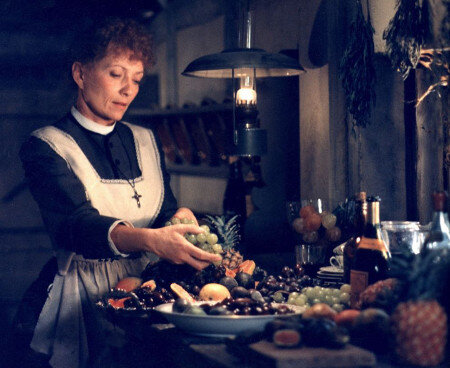Two Priests in "Babette's Feast": Babette Hersant
Over the weekend, I watched the 1987 Danish classic Babette’s Feast, directed by Gabriel Axel. I first watched this movie as part of delivering an Introduction to Catholicism course at DePaul University back in 2013-4, and watched that movie a number of times over the course of that academic year.
One of the fascinating things about Babette’s Feast is that in spite of its relatively simple plot - Frenchwoman cooks voluptuous French food for strict Protestant townsfolk and awkward transformation ensues - something new always seems to pop up with every watch. With this re-visitation, it was no different.
In the next two posts, I hope to lay out a theme that came out especially clearly in this viewing of Babette’s Feast, namely the theme of priesthood. In particular, I hope to bring out the priestly role played out in the actions of two characters. In this first post, I wish to focus on the titular character, the French refugee Babette Hersant. In the second, I would focus on the Swedish soldier, Lorens Loewenhielm.
What is remarkable is that neither are themselves priests, yet their actions bring out in distinct ways a priestly role manifested in a liturgical setting, in the person of the sacramental priest. At the same time, this movie demonstrates that precisely because of this liturgical setting, the priestly role is mediated through the priest to all of the faithful, thereby making possible the priestly character of the actions of these two characters.
We focus now on Babette who, as indicated above, cooks the dinner that becomes the culmination as well as the turning point of the whole movie. As the movie indicates at the end, this is no ordinary French dinner. The feast is an act of love in which Babette expends her skill, her energy and (Spoiler alert), all her money (and with it, her ability to leave Denmark and return to France).
While Catholics might recognise a sacramental quality to the food that is produced, what seems less straightforward is the way in which Babette’s act of preparing and serving this meal bears within it a liturgical quality. The meal is a solemn liturgy in which Babette plays a crucial - priestly - role.
One gets a sense of this liturgical quality in a scene that precedes the feast. Babette, having sourced the ingredients for her dinner from France, brings them to the house in which she lives. As she does so, she ends up leading a solemn procession in which meat, fish, quails and a turtle are carried through the middle of the village, in full view of every villager.
In the kitchen, Babette does more than display her skill as a cook. As mentioned before, she expends herself, pours herself into every dish (including one very important pie) which is then given to the guests gathered, such that it becomes difficult to distinguish the dish from Babette (indeed, on the eve of the dinner, one of the guests, Martine, has a nightmare in which the food and its cook blur into a single vision).
Why this is important can be gleaned in the first instance from John Paul II’s final encyclical, Ecclesia de Eucharistia. In this document, John Paul II describes the center of gravity of the Church, which is the act of worship in the Eucharistic liturgy. “The Church”, John Paul II says in the beginning of the document,
…draws her life from the Eucharist. This truth does not simply express a daily experience of faith, but recapitulates the heart of the mystery of the Church (1).
The Eucharist, in turn, has its own centre of gravity, which is Jesus Christ Himself. But Jesus is not an inert presence in the Eucharist, but is active and acting. This is made clear in paragraph 11 of the encyclical:
The Church has received the Eucharist from Christ her Lord not as one gift – however precious – among so many others, but as the gift par excellence, for it is the gift of himself, of his person in his sacred humanity, as well as the gift of his saving work (11).
Christ, having poured himself out as a unique libation on the cross, continues to pour Himself out in every Eucharist that is celebrated.
The priestly role is then put into sharp relief in an article in the Homiletic Pastoral Review by Vincent Miller. The priest is not a mere liturgical factory worker, assembling the elements that make Jesus present. Rather, Miller says, the priest “enters into Christ’s self-gift” from the moment of his ordination. Christ’s pouring out of the Eucharist finds an extension, first and foremost in the sacramental priest that celebrates the Eucharist.
However, this priestly pouring out does not stop with the person of the priest. In receiving the Eucharist, the congregation does not merely keep its Jesus up like hydration levels. Rather, receiving the Eucharist is a call to “become what you receive” (in Augustine’s words), that is to mimic Christ’s priestly role, that is, mimic Christ in making a gift of oneself for the life of the world.
To bring this back to Babette, her priestly role comes into play at the precise moment she decides to give her whole life - her labour, her money and her mobility - for the life of this little Lutheran congregation that have gathered round the dinner table. The staid pious platitudes that plaster over a reality of lifelessness, are suddenly transformed into a myriad of life giving moments in the lives of the diners. Reconciled rivals, rekindled love and fear transformed into thanksgiving.
To be continued in next week’s post…
Support Awkward Asian Theologian on Patreon, and help make a change to the theological web.




